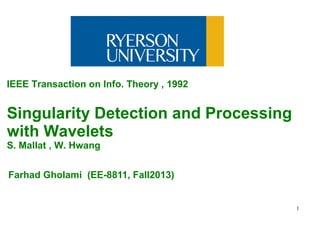
Singularity Detection using Wavelet Transform Maxima
- 1. 1 Farhad Gholami (EE-8811, Fall2013) IEEE Transaction on Info. Theory , 1992 Singularity Detection and Processing with Wavelets S. Mallat , W. Hwang
- 2. 3 Introduction: Abrupt changes in a signal, produce relatively large wavelet coefficients centered around the discontinuity at all scales. The wavelet transform makes it possible to localize regularities(time, location) of signal.
- 3. 4 Set of CWT coefficients affected by the singularity increases with increasing scale ( cone of influence). The most precise localization of the discontinuity based on the CWT coefficients is obtained at the smallest scales.
- 4. 5 Concept of Lipschitz Exponent (LE): There is a double cone (shown in white) whose vertex can be translated along the graph, so that the graph always remains entirely outside the cone. A signal is regular if it can be locally approximated by a polynomial.
- 6. 7 Point-wise regularity of a signal related to the decay of its wavelet transform: Detecting singularities this way, numerically is complex !!!! Reqularity measurments:
- 7. 8 The Wavelet Transform Modulus Maxima (WTMM): A method for detecting the fractal dimension of a signal. By calculating CWT for subsequent wavelets (derivatives of the mother wavelet) singularities can be identified. Signal represented by polynomial: . Successive derivative wavelets remove the contribution of lower order terms in the signal, allowing the maximum “hi” to be detected. When taking derivatives, lower order =0.
- 8. 9 Wavelet transform local maxima are related to the singularities of the signal. Detection of singularities:
- 9. 10 Function is not singular if CWT has no local maxima. This theorem indicates the presence of a maximum at the finer scales where a singularity occurs.
- 10. 11 This theorem indicates the presence of a maximum at the finer scales where a singularity occurs. Modulus maxima of a 1-D signal
- 12. 13 Most of signals can be reconstructed using only local maximas value and location of of dyadic (power of two) sequence of scales very very good precision. This is a basis for de-noising and edge detection algorithms Reconstruction of signal using local Maxima:
- 13. 14 Lipschitz continuity is related to the wavelet transform:
- 14. 15 Evolution of local maxima amplitude across scales we can determine which ones are created by white noise. De-noising Algorithm: Remove all maxima whose amplitude increases on average when scale decreases . Noise LE of White noise is negative.
- 15. 17 Multiscale edge detection: A method of edge detection on across scales to obtain satisfactory results on image+white noise noise. keep the scales small for locations with positive, increase scales for locations with negative Lipschitz regularity
- 16. 18 Conclusion: Wavelet local maxima detect all the singularities of a function. and characterize their Lipschitz regularity. This provides algorithms for characterizing the singularities. Signal can separated from noise using evolution of local maxima evolution as scale changes . We can reconstruct the signal from remaining local maxima (denoise). Image edges like other singularities can be detected and processed using local maxima.
